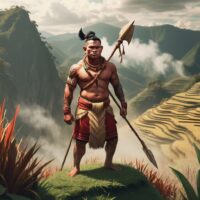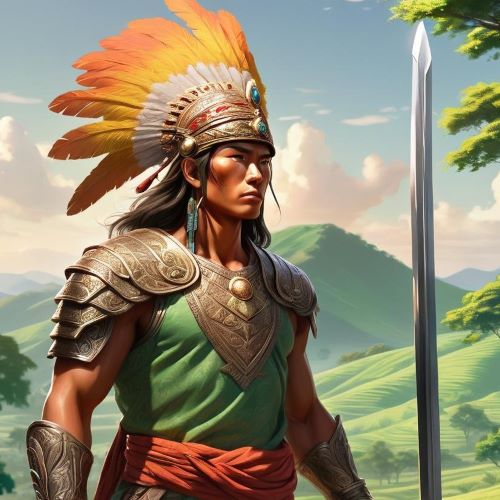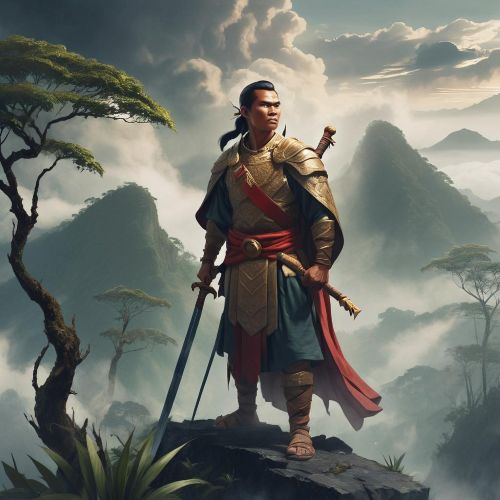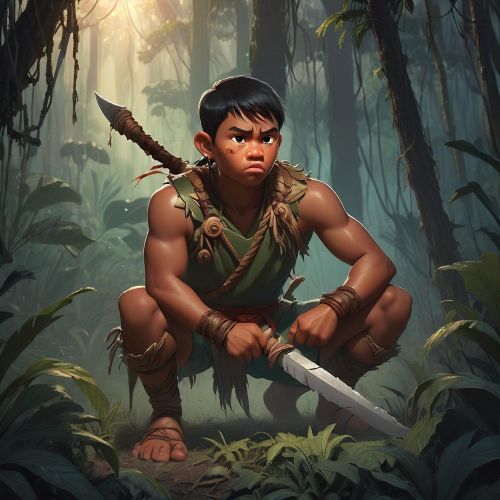Pumbakhayon : The Legendary Warrior
Listen
At a glance
| Description | |
|---|---|
| Origin | Philippine Mythology |
| Classification | Mortals |
| Family Members | Pagan (Father), Bugan (Sister), Aginaya (Wife) |
| Region | Philippines |
| Associated With | Bravery, Warfare |
Pumbakhayon
Introduction
Pumbakhayon is a legendary warrior from the Hudhud chants of the Ifugao people in the Philippines, one of the most enduring oral epics in Southeast Asia. His story is central to the Hudhud hi Aliguyon, a cycle of chants that narrates the lives of heroic figures and embody the values of courage, kinship, and reconciliation. The Hudhud tradition itself has been recognized by UNESCO as a Masterpiece of the Oral and Intangible Heritage of Humanity, underscoring its cultural importance.
Unlike many mythical heroes who rely solely on force, Pumbakhayon is remembered not only for his unmatched combat skills but also for his ability to transform rivalry into kinship. His long duel with Aliguyon, the protagonist of the epic, becomes a narrative of mutual respect and ultimately leads to peace between two warring villages. In this way, Pumbakhayon embodies both the warrior’s strength and the statesman’s wisdom, making him one of the most significant figures in Philippine mythology.
Physical Traits
The Hudhud chants do not dwell on literal physical descriptions but instead highlight Pumbakhayon’s heroic qualities through metaphor and symbolic imagery. He is consistently portrayed as a warrior of remarkable presence, one whose physique and bearing reflect both strength and nobility. His sharp eyesight, agility, and unmatched coordination mark him as an extraordinary fighter.
Ifugao traditions often imagine him clothed in warrior regalia typical of the highlands: a wanoh or loincloth, beadwork, and warrior tattoos signifying valor. His weapons—particularly the spear and shield—are not just instruments of war but symbols of authority and ancestral strength. In artistic depictions and oral recitations, Pumbakhayon commands respect through the aura of a man destined for greatness, a figure whose very appearance signifies courage.
Family
Family plays a crucial role in Pumbakhayon’s story, anchoring his life within the broader kinship structures of the Ifugao people. He is the son of Pangaiwan, the leader of Daligdigan, and Dangunay, his mother. His sister, Bugan, also features in the narrative, reflecting the common Hudhud motif of sibling pairs whose lives intersect with those of rival families.
Conflict in the Hudhud is often framed as an extension of inherited rivalries, and Pumbakhayon’s initial hostility toward Aliguyon stems from the enmity between their fathers, Pangaiwan and Amtalao. However, the story evolves beyond this inherited animosity. After years of inconclusive combat, Pumbakhayon marries Aginaya, Aliguyon’s sister, forging peace through kinship. This exchange marriage represents a symbolic resolution to blood feuds, embodying the Ifugao cultural practice of transforming rivalry into lasting alliances.
Other names
Within the Hudhud chants, Pumbakhayon is most commonly referred to simply by his given name. However, he is also celebrated by epithets that emphasize his role in the epic cycle. He is often called the “warrior of Daligdigan,” identifying him with his home village, and in some retellings he is described as the “rival of Aliguyon,” underscoring his place in the famous duel. Modern interpretations sometimes highlight his legacy as a “peacebringer,” focusing on the reconciliation that ends his rivalry with Aliguyon. These variations in naming reflect the different facets of his character—warrior, rival, and diplomat.
Powers and Abilities
Pumbakhayon’s reputation as a mythic hero rests on both martial skill and supernatural aptitude. He is described as the equal of Aliguyon, matching him in every contest of strength, endurance, and cunning. Their duel, which lasts for three years, demonstrates his unmatched stamina and combat mastery. One striking episode recounts how Pumbakhayon effortlessly catches a spear thrown at him and hurls it back with precision—only for Aliguyon to do the same. This seemingly endless exchange reflects the supernatural prowess attributed to both men.
Beyond combat, Pumbakhayon is also connected with magical abilities and deep spiritual knowledge. Like many figures in Ifugao mythology, he is believed to act with the guidance of spirits, and his mastery of strategy and trickery—such as diverting watercourses to outwit his opponents—adds to his legendary aura. Importantly, he is not remembered merely as a fighter but as a culture-bearer, credited in some versions with imparting the Hudhud chants themselves to the women harvesters of Kiangan. This dual role of warrior and teacher elevates him to a revered status in the community’s cultural memory.
Modern Day Influence
The legacy of Pumbakhayon endures through the survival of the Hudhud chants, which continue to be performed during harvests, funerals, and other rituals. In 2001, UNESCO recognized the Hudhud of the Ifugao as part of the world’s Intangible Heritage, drawing global attention to its historical and cultural value. This recognition has inspired renewed efforts to teach, perform, and preserve the chants among younger generations.
Despite these efforts, modernization and shifts in religious practice have contributed to a decline in oral traditions. Some Ifugao youth encounter the Hudhud only briefly in school performances and may not fully grasp its depth and complexity. Elders have expressed concern that irregular recitation threatens the continuity of this cultural treasure. Still, the figure of Pumbakhayon remains an inspiring presence, symbolizing bravery, reconciliation, and the enduring wisdom of indigenous heritage.
In contemporary culture, his influence appears in literature, performing arts, and educational materials that seek to keep the Ifugao identity alive. Artists and storytellers reinterpret his exploits through visual art and digital media, presenting him to modern audiences in fresh ways while retaining the essence of his heroism. For the Ifugao and for Filipinos at large, Pumbakhayon remains a powerful reminder that true strength lies not only in the ability to wage war but also in the capacity to build peace.
Related Images
Source
Stanyukovich, M. (2006). Factors affecting stability/variability of the Ifugao hudhud. Retrieved from https://sil-philippines-languages.org/ical/papers/stanyukovich-hudhud.pdf
UNESCO Intangible Cultural Heritage. (n.d.). STUDENTS. Retrieved from https://ich.unesco.org/doc/src/Teaching_guide_for_students:_Hudhud_Schools_for_Living_Tradition.pdf
Clarkmonding. (2011, March 19). Aliguyon – Magical Creatures. Retrieved from http://clarkmonding.blogspot.com/2011/03/aliguyon.html
Philsites.net. (n.d.). Tales of Heroism – Hudhud hi Aliguyon. Retrieved from https://www.philsites.net/folklore/stories/heroism1.html
Brainly.ph. (2020, September 19). HOW IS PUMBAKHAYON CHARACTERISZED?. Retrieved from https://brainly.ph/question/3088022
Wikipedia. (2019, April 25). Hudhud ni Aliguyon. Retrieved from https://en.wikipedia.org/wiki/Hudhud_ni_Aliguyon
Academia.edu. (n.d.). (DOC) Story of Hudhud ni Aliguyon. Retrieved from https://www.academia.edu/26967177/Story_of_Hudhud_ni_Aliguyon
UNESCO Intangible Cultural Heritage. (n.d.). Hudhud Chants of the Ifugao. Retrieved from https://ich.unesco.org/doc/src/Teaching_guide_for_students:_Hudhud_Schools_for_Living_Tradition.pdf
De La Salle University – Dasmariñas. (n.d.). Pumbakhayon : an origin myth of the Ifugao hudhud …. Retrieved from https://hslrc.dlsud.edu.ph/cgi-bin/koha/opac-detail.pl?biblionumber=68997
Torrossa.com. (2011). Tales from the 7,000 Isles. Retrieved from https://www.torrossa.com/gs/resourceProxy?an=5531495&publisher=FZ0661
Dulay, M. J. (2015). The Ifugao Hudhud: Its Values Content. International Journal of Science and Research, 4, 2776–2777.
Manuel, E. A. (1963). A Survey of Philippine Folk Epics. Asian Folklore Studies, 22, 1–76.
Tobias, M. A. (2006). Pumbakhayon: An origin myth of the Ifugao hudhud. National Commission for Culture and the Arts-Intangible Heritage Committee.
Frequently Asked Questions
What is lorem Ipsum?
I am text block. Click edit button to change this text. Lorem ipsum dolor sit amet, consectetur adipiscing elit. Ut elit tellus, luctus nec ullamcorper mattis, pulvinar dapibus leo.
What is lorem Ipsum?
I am text block. Click edit button to change this text. Lorem ipsum dolor sit amet, consectetur adipiscing elit. Ut elit tellus, luctus nec ullamcorper mattis, pulvinar dapibus leo.
What is lorem Ipsum?
I am text block. Click edit button to change this text. Lorem ipsum dolor sit amet, consectetur adipiscing elit. Ut elit tellus, luctus nec ullamcorper mattis, pulvinar dapibus leo.
What is lorem Ipsum?
I am text block. Click edit button to change this text. Lorem ipsum dolor sit amet, consectetur adipiscing elit. Ut elit tellus, luctus nec ullamcorper mattis, pulvinar dapibus leo.
What is lorem Ipsum?
I am text block. Click edit button to change this text. Lorem ipsum dolor sit amet, consectetur adipiscing elit. Ut elit tellus, luctus nec ullamcorper mattis, pulvinar dapibus leo.










